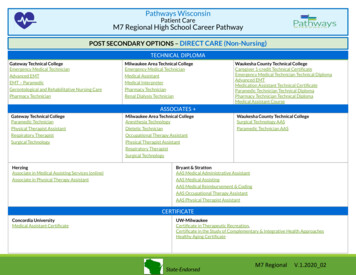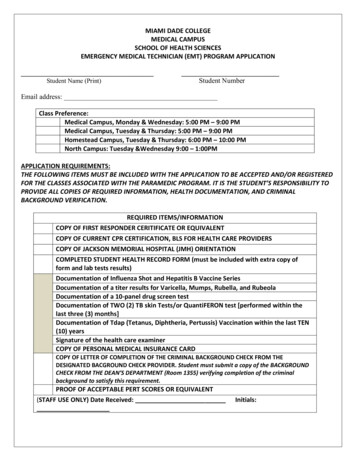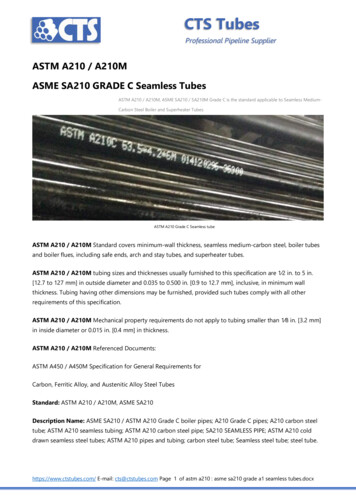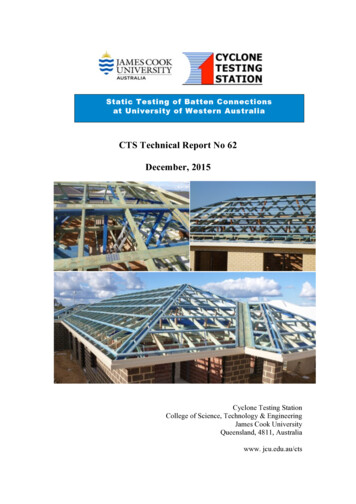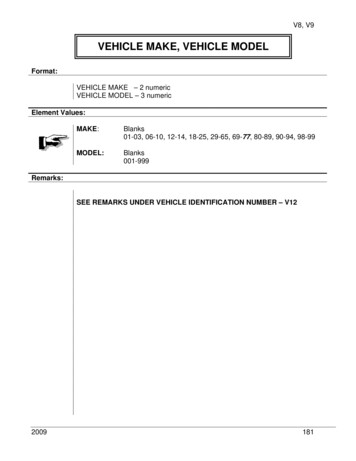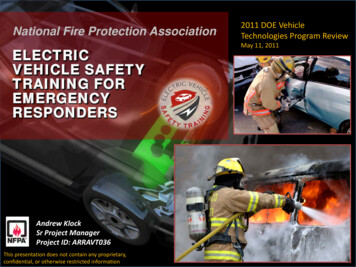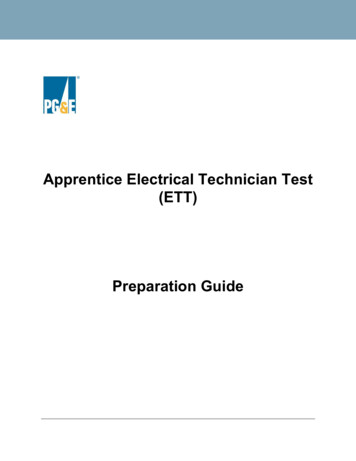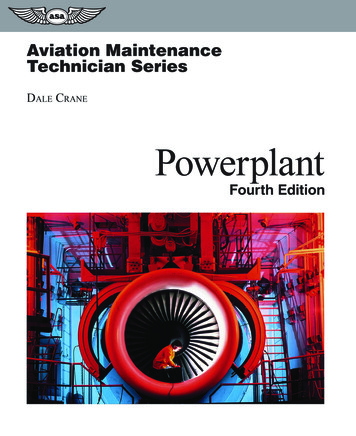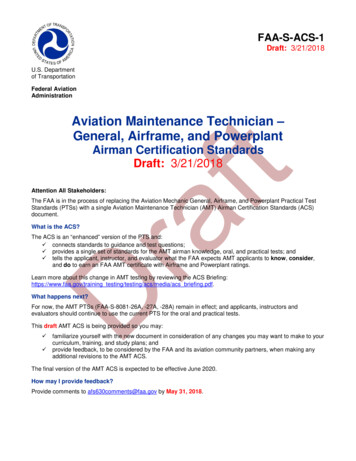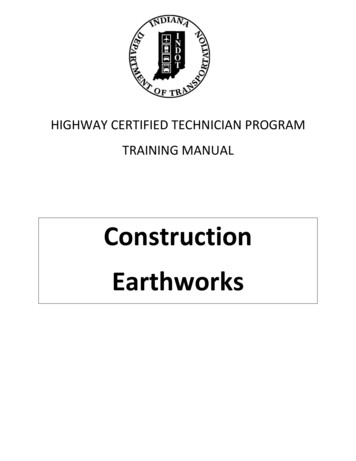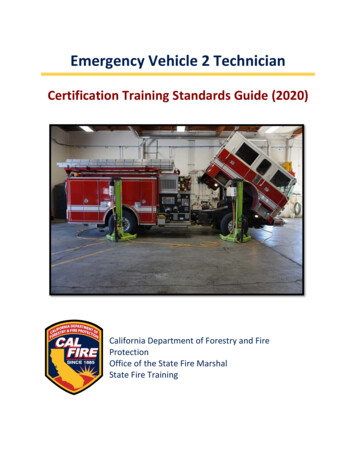
Transcription
Emergency Vehicle 2 TechnicianCertification Training Standards Guide (2020)CAL FIRE LogoDocument TitleCalifornia Department of Forestry and FireProtectionOffice of the State Fire MarshalState Fire Training
Emergency Vehicle Technician 2Certification Training Standards Guide (2020)This CTS guide utilizes NFPA 1071 Standard for Emergency Vehicle Technician ProfessionalQualifications (2020) to provide the qualifications for State Fire Training’s Emergency VehicleTechnician certification.State Fire Training coordinated the development of this CTS guide. Before its publication, theStatewide Training and Education Advisory Committee (STEAC) and the State Board of FireServices (SBFS) recommended this CTS guide for adoption by the Office of the State FireMarshal (OSFM).Published by State Fire Training.Published January 2021Cover photo courtesy of Lawrence Achen, Central Fire Protection District, Santa Cruz, CA
Table of ContentsState Fire Training . 1Acknowledgments. 2How to Read a CTS Guide. 4Emergency Vehicle Technician 2 . 6Section 1: Definition of Duties . 61-1: Definition of Duties for an Emergency Vehicle Technician 2 . 6Section 8: Electronic and Electrical Systems. 78-1: Repairing Low-voltage Electrical Systems. 78-2: Testing Low-voltage Electrical System Components. 98-3: Inspecting Electronic Controls and Instrumentation. 118-4: Maintaining Electronic Controls and Instrumentation . 138-5: Repairing Electronic Controls and Instrumentation . 148-6: Testing Electronic Controls and Instrumentation . 16Section 9: Aerial Systems . 189-1: Repairing Aerial Sections, Booms, and Platforms. 189-2: Repairing Aerial Device Stabilization Systems . 199-3: Maintaining Aerial Device Lifting, Rotating, and Extension Systems . 209-4: Repairing Aerial Device Lifting, Rotating, and Extension Systems. 229-5: Repairing Aerial Hydraulic Systems . 239-6: Repairing Aerial Device Electrical and Electronic Systems . 249-7: Repairing Aerial Device Waterway Systems . 259-8: Testing Aerial Devices, Systems, and Related Components . 26Section 10: Specialized Systems. 2710-1: Repairing Electrical Line Voltage Generation Systems . 2710-2: Testing Electrical Line Voltage Electrical Systems . 2910-3: Repairing Line Voltage Appliances and Controls . 30State Fire Training Content. 31Errata. 33
Emergency Vehicle Technician 2State Fire TrainingState Fire TrainingMissionTo enable the California Fire Service to safely protect life and property through education,training, and certification.The California Fire Services Training and Education SystemThe California Fire Service Training and Education System (CFSTES) was established to provide asingle statewide focus for fire service training in California. CFSTES is a composite of all theelements that contribute to the development, delivery, and administration of training for theCalifornia fire service. The authority for the central coordination of this effort is vested in theTraining Division of the California State Fire Marshal's Office with oversight provided by theState Board of Fire Services.CFSTES facilitates, coordinates, and assists in the development and implementation ofstandards and certification for the California fire service. CFSTES:1. Administers the California Fire Academy System2. Provides accredited courses leading to certification and approved standardized trainingprograms for local and regional delivery3. Administers the national accreditation process in California4. Publishes certification training standards, course plans, and a capstone task book for eachcertified level in the California fire serviceCFSTES is a fire service system developed by the fire service, for the fire service. It is only assuccessful and effective as the people involved in it.Published January 2021Page 1 of 34
Emergency Vehicle Technician 2AcknowledgmentsAcknowledgmentsState Fire Training appreciates the hard work and accomplishments of those who built the solidfoundation on which this program continues to grow.State Fire Training gratefully acknowledges the following individuals and organizations for theirdiligent efforts and contributions that made the development and publication of this documentpossible.CAL FIRE Thom Porter, Director Mike Richwine, State Fire Marshal Andrew Henning, Chief of State Fire Training John Binaski, Chair, Statewide Training and Education Advisory Committee (STEAC)Cadre Leadership Jim Eastman, Cadre Lead, Training Specialist III, (RA), CAL FIRE, Deputy Chief (ret.),Sacramento Metro Fire District Allison L. Shaw, Editor, California State University, SacramentoPublished January 2021Page 2 of 34
Emergency Vehicle Technician 2AcknowledgmentsCadre Members Lawrence Achen, Training Captain, Central Fire Protection District, Santa Cruz, VicePresident, California Fire Mechanics Academy, Inc. John Borges, Operations Manager, Burtons Fire, Inc., Modesto Anthony Bulygo, Santa Clara County Fire Department (retired), Northern/SouthernCalifornia Liaison, California Fire Mechanics Association Boyd Clegg, San Ramon Valley Fire Protection District (retired), Vacaville FireProtection District (retired), Instructor, California Fire Mechanics Academy, Inc. Doug Link, San Miguel Fire Protection District (retired), Treasurer, California FireMechanics Academy, Inc. Mark Mclean, Fire Fighter, Los Angeles Fire Department Rick Nogueira, Fleet Mechanic, San Ramon Valley Fire Protection District, President,Northern California Fire Mechanics Association Marty Schmeltz, Emergency Vehicle Services Advisor, Valley Power Systems, BoardMember, California Fire Mechanics Academy, Inc.PartnersState Fire Training also extends special acknowledgement and appreciation to the Conferenceand Training Services Unit with the College of Continuing Education at California StateUniversity, Sacramento, for its ongoing meeting logistics and curriculum development support,innovative ideas, and forward-thinking services. This collaboration is made possible through aninteragency agreement between CAL FIRE and Sacramento State.Published January 2021Page 3 of 34
Emergency Vehicle Technician 2How to Read a CTS GuideHow to Read a CTS GuideState Fire Training develops a Certification Training Standards (CTS) Guide for a variety of jobfunctions in the fire service such as firefighter, driver/operator, fire instructor, and companyofficer. The CTS guide lists the requisite knowledge and skills and the job performancerequirements a person is expected to complete in order to become certified in a specificfunction. CTS guides are appropriate for fire service personnel and individuals in relatedoccupations pursuing State Fire Training certification.Each CTS guide serves as a foundation for the certification programs recommended foradoption by the Office of the State Fire Marshal. Any certification program must be based onjob-related knowledge and measurable performance standards. To master the knowledge andskills needed for specialized operations, individuals will require additional training to augmentthe performance standards included in the CTS guide.Within the CTS guide, it is impossible to capture the different policies and procedures of eachorganization in the California fire service. Individuals aspiring to meet State Fire Training’scertification training standards must do so in accordance with the codes, standards,regulations, policies, and standard operating procedures applicable within their owndepartments or jurisdictions.FormatEach certification training standard included in the CTS guide includes the following:Section HeadingThe section heading describes a general category for a group of training standards. Forexample, the Fire Marshal CTS includes the following sections: Administration, RiskManagement, Community Relations, Professional Development, Regulatory Programs, Fire andLife Safety, and Investigation. Each section contains one or more individual training standards.Training Standard TitleThe training standard title provides a general description of the performance requirementcontained within the standard.AuthorityThe CTS guide references each standard with one or more paragraphs of the correspondingNational Fire Protection Association (NFPA) Professional Qualifications. This ensures that eachfire service function within California's certification system meets or exceeds NFPA standards.Published January 2021Page 4 of 34
Emergency Vehicle Technician 2How to Read a CTS GuideWhen California requirements exceed the NFPA standard, the CTS guide cites the Office of theState Fire Marshal as the authority and prints the corresponding information in italics.GivenThis section lists the objects, equipment, materials, or facilities an individual needs in order toacquire the requisite knowledge and skills or to accomplish the job performance requirement(s)within a training standard.Requisite Knowledge and SkillsThis section lists the knowledge and skills that an individual must acquire in order to accomplishthe job performance requirement(s) within a training standard.This section does not include NFPA requisite knowledge or skills that are too general to teach orthat individuals should develop through life experiences. For example, a training standardwould not list “communicate orally and in writing” or “ability to relate interpersonally” unlessthey specifically apply to a job performance requirement about acquiring communication skillsor developing interpersonal relationships.Job Performance RequirementsThis section includes one or more written statements that describe a specific job-related taskand define measurable or observable outcomes. After an individual completes all courseworkand requisite requirements, the capstone task book process verifies completion of jobperformance requirements.ContentIn addition to the individual certification training standards, the CTS guide also includes StateFire Training Revisions and Errata pages.State Fire Training ContentLocated at the back of the CTS guide, this table documents any significant revisions made byState Fire Training to the NFPA standards in the development of this CTS guide. This table isused to justify content additions and advise the course plan development team.ErrataLocated at the back of the CTS guide, this page documents any changes made to the CTS guideoutside of the five-year NFPA revision cycle.Published January 2021Page 5 of 34
Emergency Vehicle Technician 2Section 8: Electronic and Electrical SystemsEmergency Vehicle Technician 2Section 1: Definition of Duties1-1: Definition of Duties for an Emergency Vehicle Technician 2AuthorityNFPA 1071 Standard for Emergency Vehicle Technician Professional Qualifications (2020) Paragraph 5.1.1 Paragraph 5.1.2 Paragraph 5.2 Paragraph 5.3 Paragraph 5.4 Paragraph 5.5 Paragraph 5.6 Paragraph 5.7Given1. There are no givens identified for this training standardRequisite Knowledge and Skills1. Identify the repair, performance testing, and weight verification duties associated withchassis systems of an EVT 22. Identify the repair duties associated with cabs (fixed and tilt) and vehicle bodies of an EVT 23. Identify the repair, operational testing, and performance testing duties associated withelectronic and electrical systems (low voltage) of an EVT 24. Identify the inspection, repair, maintenance, and operational testing duties associated withat least one of the following systems: pump and tank systems, aerial systems, or specialized(foam, line voltage electrical, breathing air, auxiliary air) systems of and EVT 2Job Performance RequirementsThere are no job performance requirements identified for this training standard.Published January 2021Page 6 of 34
Emergency Vehicle Technician 2Section 8: Electronic and Electrical SystemsSection 8: Electronic and Electrical Systems8-1: Repairing Low-voltage Electrical SystemsAuthorityNFPA 1071 Standard for Emergency Vehicle Technician Professional Qualifications (2020) Paragraph 5.4.1Given1.2.3.4.5.6.An emergency response vehicleManufacturer specificationsAn assignment or inspection report detailing a deficiency or deformationStandard operating procedures (SOPs)Test, calibration, and diagnostic equipmentToolsRequisite Knowledge and Skills1. Describe the function, construction, and operation of starting motors, alternators, andaccessory electric motors, relays, solenoids, and regulators2. Describe repair and overhaul procedures3. Describe the theory of electricity4. Describe operational, diagnostic, and performance tests5. Describe adjustment and calibration procedures6. Describe how to select test, calibration, and diagnostic equipment7. Identify common defects8. Describe electrical troubleshooting procedures9. Identify record-keeping requirements10. Describe the diagnostic and repair procedures of the manufacturer and the authority havingjurisdiction11. Recognize, evaluate, and identify reported conditions12. Perform required repairs to resolve deficiencies13. Use test, calibration, and diagnostic equipment14. Measure voltage, amperage, and resistance15. Distinguish defects and deficiencies16. Operate and test system17. Perform electrical calculations18. Complete required documentationJob Performance RequirementsPerform repairs on low-voltage electrical system components so that defective components arediagnosed; deformed, broken, loose, worn, or missing parts of low-voltage electrical systemPublished January 2021Page 7 of 34
Emergency Vehicle Technician 2Section 8: Electronic and Electrical Systemscomponents are repaired, replaced, or rebuilt to manufacturer specifications; charging systems,starting systems, lighting systems, electrical accessories, and other electrical systems arereturned to operation; correct test equipment is used; hazards are avoided; correct parts areused; diagnostic checks are conducted and performance is verified; and repairs aredocumented in accordance with the procedures of the manufacturer and the authority havingjurisdiction.Published January 2021Page 8 of 34
Emergency Vehicle Technician 2Section 8: Electronic and Electrical Systems8-2: Testing Low-voltage Electrical System ComponentsAuthorityNFPA 1071 Standard for Emergency Vehicle Technician Professional Qualifications (2020) Paragraph 5.4.3Given1.1.2.3.4.An emergency response vehicleManufacturer specificationsSOPsTest, calibration, and diagnostic equipmentToolsRequisite Knowledge and Skills1. Describe the function, construction, and operation of starting motors, alternators, relays,solenoids, and regulators2. Describe repair and overhaul procedures3. Describe the theory of electricity4. Describe operational, diagnostic checks, and performance tests5. Describe adjustment and calibration procedures6. Describe how to select test, calibration, and diagnostic equipment7. Identify common defects8. Describe electrical troubleshooting procedures9. Identify record-keeping requirements10. Describe the diagnostic and repair procedures of the manufacturer and the authority havingjurisdiction11. Recognize, evaluate, and identify reported conditions12. Perform required repairs to resolve deficiencies13. Use test, calibration, and diagnostic equipment14. Measure voltage, amperage, and resistance15. Distinguish defects and deficiencies16. Operate and diagnostically check system and complete performance tests17. Perform electrical calculations18. Complete required documentation in accordance with NFPA standards and the authorityhaving jurisdictionJob Performance RequirementsComplete performance testing on low-voltage electrical system components includingbatteries, charging systems, starting systems, onboard chargers, electrical loads, solenoids, andrelay devices in accordance with NFPA 1911 so that components are performance tested toassure they are operating in accordance with manufacturer specifications and NFPA standards;performance tests are conducted to verify that repairs are completed; and all testing isPublished January 2021Page 9 of 34
Emergency Vehicle Technician 2Section 8: Electronic and Electrical Systemsdocumented in accordance with the procedures of the manufacturer and the authority havingjurisdiction.Published January 2021Page 10 of 34
Emergency Vehicle Technician 2Section 8: Electronic and Electrical Systems8-3: Inspecting Electronic Controls and InstrumentationAuthorityOffice of the State Fire MarshalGiven1.2.3.4.5.6.7.An emergency response vehicleSOPsManufacturer specificationsToolsTest, calibration, and diagnostic equipmentSchematicsAn inspection checklistRequisite Knowledge and Skills1.2.3.4.5.6.7.Describe how the principles of magnetism apply to electronic control devicesDescribe how the principles of electricity apply to electronic control devicesDescribe the principles of circuit analysisDescribe how to select test, calibration, and diagnostic equipmentDescribe test, calibration, and diagnostic equipment to avoidUse test, calibration, and diagnostic equipmentDescribe the function, construction, operation, and requirements of electronic controls andinstrumentation8. List types of defects, deficiencies, and potential problems associated with electronic controlsand instrumentation9. Determine defects and deficiencies10. Describe how to read and interpret schematics11. Read and interpret schematics12. Identify mounting and adjustment requirements13. Recognize and identify potential failure symptoms and conditions of electronic controls andinstrumentation14. Describe the inspection procedures of the manufacturer and the AHJ15. Recognize and identify symptoms and conditions of electronic control and instrumentationissues16. Determine defects, deficiencies, and potential problems17. Perform operational tests18. Identify record-keeping requirements19. Complete checklist and inspection documentationJob Performance RequirementsInspect the electronic controls and instrumentation so that the mounting security is verified;operation and condition of the electronic control system
certification training standards must do so in accordance with the codes, standards, regulations, policies, and standard operating procedures applicable within their own . of an EVT 2 4. Identify the inspection, repair, ma
